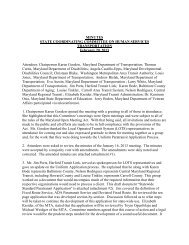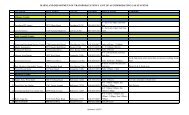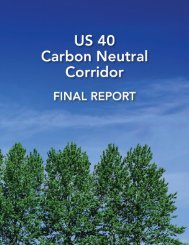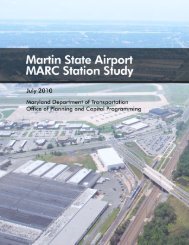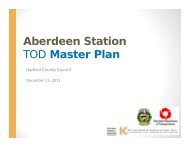PB PlaceMaking - Maryland Department of Transportation
PB PlaceMaking - Maryland Department of Transportation
PB PlaceMaking - Maryland Department of Transportation
Create successful ePaper yourself
Turn your PDF publications into a flip-book with our unique Google optimized e-Paper software.
Illustration <strong>of</strong> parking behind buildings<br />
Example <strong>of</strong> parking behind buildings<br />
Example <strong>of</strong> mixed-use parking structure<br />
Development Concept<br />
Parking Strategy<br />
Reducing automobile dependency, a basic principal <strong>of</strong> TOD, requires<br />
minimizing and consolidating parking. A viable, comprehensive<br />
parking management program for commercial and residential<br />
development will be essential to the Eutaw District’s success. The<br />
program must consider and include three key features:<br />
1. Increased transit use. The two rail transit stations located<br />
on the site will serve the increased numbers <strong>of</strong> employees,<br />
residents and visitors that utilize the new development. It is<br />
anticipated that a number <strong>of</strong> the new residents will work in<br />
nearby areas connected to the State Center Complex by LRT or<br />
Metro. In addition, the marketability <strong>of</strong> the area as a bedroom<br />
community for the DC Metro Area, coupled with the site’s<br />
proximity to Penn Station, will facilitate use <strong>of</strong> commuter rail.<br />
2. Reduced vehicle use. TOD allows people living and working<br />
in the District to walk, bike or use transit to satisfy many <strong>of</strong><br />
their daily needs, thus reducing auto use and the corresponding<br />
demand for parking.<br />
3. Shared parking. Land uses with different peak parking demand<br />
periods can share the same parking spaces over a longer period<br />
<strong>of</strong> each day. For instance, a movie theater primarily needs<br />
parking in the evenings and on weekends, while an <strong>of</strong>fice<br />
chiefly requires daytime weekday parking. The concentration<br />
<strong>of</strong> cultural activities and <strong>of</strong>fice space in close proximity to<br />
one another facilitates shared parking, reducing the need for<br />
individual parking for each use.<br />
Due to the region’s existing reliance on the use <strong>of</strong> automobiles, it is<br />
recommended that adequate parking remain available until the plan<br />
area has established itself and the benefits <strong>of</strong> the TOD are apparent.<br />
The parking strategy will work in accordance with the TOD strategy<br />
as whole; existing land used for parking will become more valuable<br />
and converted to development as the benefits <strong>of</strong> TOD become more<br />
established.<br />
State Center Transit Oriented Development Strategy 35



